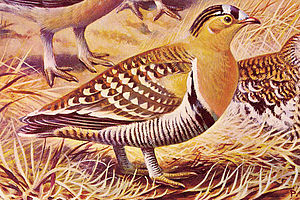Their synchronised pattern of drinking became apparent to me while working in the Namib Desert and later in Etosha. I began associating sunset with their sudden appearance at watering places, noting that they arrive with uncanny precision during the brief window of time that divides day and darkness. Eventually, my curiosity about this predictable behaviour caused me to accurately record my earlier, casual observations. To do this, I enlisted the assistance of several people and we followed the same, strict protocol several times a week, over a period of one year. A number of factors appeared to be involved, for example, the time of sunset changes daily, albeit imperceptibly. Consequently, to accurately record this, we used a Global Positioning System (GPS) that gave the exact time of sunset at the water hole we were observing. Timing this by stopwatch, we proceeded to note: arrival of the first sandgrouse, estimated maximum number of birds present, disturbance by other animals, cloud cover, rainfall, and time when the last sandgrouse flew off. Powerful floodlights at Okaukuejo, Halali and Namutoni rest camps illuminate the water holes, so we also noted the time when these were automatically activated, to ascertain whether the artificial light had any influence.
It was fascinating work. I became absorbed by the regularity with which these swift flyers appeared, homing in to a water hole with uncanny timing. Sunset’s silence was broken for about half–an–hour as the sandgrouse vocalised, their combined voices rising in volume when their numbers reached a peak. The sound resembled a chorus of many frogs. It gave the impression that the birds were engaged in conversation and that this brief period was when they could socialise before flying away to all points of the compass. On occasions they emitted a distinctive, softer, “churring” note. Earlier research hypothesizes that this call may have evolved from imitating the Suricate, by sounding like the growling of this fierce little member of the mongoose family. It may well be that such a call would make the defenceless sandgrouse sound dangerous to would–be predators. Their airborne departure from drinking was invariably accompanied by a busy “chuk–chuk–chuk” note.
Sometimes their predictable pattern of arrival and departure was broken by the announced advent of elephants. Trumpeting and trunk–flaying, the herd encircled a water hole, chasing all and sundry away. Sandgrouse scattered in front of this wall of sound and movement, abandoning their congregation for that particular night. During full moon, when I spent the entire night at a water hole, a few birds came to drink throughout the hours of darkness. Some winged their way in as dawn was approaching but, during 35 years of observation, I have not witnessed them coming to drink during daylight hours. The technical term for this dusk–and–dawn activity is crepuscular, as opposed to animals that are nocturnally or diurnally active.
A year’s data showed, with results that are statistically highly significant, that Double–banded Sandgrouse arrive to drink 16 minutes after sunset on average, with a standard deviation time of 4 minutes either way. They spent, on average 28 minutes at water, flying away about 44 minutes after sunset. So predictable were these times that we joked we could set our watches by them! The significance of this synchrony is most likely that this species of sandgrouse has evolved a strategy, which favours their survival in an environment fraught with hazards. Surface water in Namibia is very limited for most of the year. Temperatures soar to dehydrating heights and flying in this heat requires debilitating energy outputs. Predators abound in the form of birds of prey, wild cats and jackals. Consequently, the hypothesis is that the primary signal which, figuratively speaking, “switches them on” comes with decreasing daylight intensity. Moreover, the cooler, denser twilight air saves flying energy and also reduces body water loss.
The challenge remaining for future research is the yet–to–be answered question of how these birds are able to find their way back to the nest when they depart from a water hole after dark, flying many kilometres over trackless bush or open desert. They will have to land unerringly at the nest, a mere shallow scrape in the ground, where their helpless chicks await the bringing of water, carried in the male’s breast feathers. Finding a water hole is relatively easy, but consider the feat of flying in exactly the right direction to locate the nest. In addition, they must know the distance accurately and they must know the length of time to fly this distance. Finally, they must do all of this by moonlight, starlight or virtually no light at all when thick clouds obscure the night sky.
Just as I became intrigued by the clockwork precision with which Double–banded Sandgrouse drink, I now find myself wondering how they complete their return journey to the nest. It will require many nights of work in the veld, coupled with far more sophisticated instruments and technology than what we used, to answer this question.
Text by Dr. Hu Berry
First published in “Flamingo” June 2005

